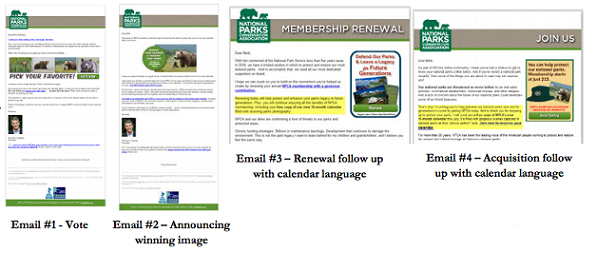
Online Engagement Increases Offline Gifts
Although online fundraising is becoming a greater source of income for many charities, it still doesn’t bring in the donations like the more traditional channels of mail, phone, etc. Some people take that information to mean your online channels shouldn’t take up very much of your charity’s time and resources, but I’ve seen how valuable online efforts can be when they are integrated as part of a larger campaign. I’ll share a recent example from our work with the National Parks Conservation Association’s (NPCA) Calendar Engagement Campaign.
NPCA recently analyzed their activist-members -- supporters who engage with NPCA in their advocacy work AND donate -- and discovered that these individuals have a stronger renewal rate. So to increase their renewals further, we decided to give their supporters the opportunity to feel more active and involved.
To facilitate the opportunities for multi-channel engagement, NPCA used a series of emails to involve and engage their supporters leading up to one of their signature appeals of the year, and the results speak for themselves.
OBJECTIVE
NPCA had been mailing a beautiful calendar appeal every year -- but Avalon found they were missing an opportunity to engage their supporters and leverage the calendar even further to bond people to the organization and strengthen the bottom line for this campaign. The calendar presented an opportunity to engage members and encourage them to join or renew their membership online ahead of mailing the calendar. This multi-effort series of emails asked members and prospects to choose the calendar cover image with follow ups asking them to join or renew to ensure they were eligible to receive the mailed calendar in a few months -- a meaningful incentive.
STRATEGY
The touch point strategy included the following emails:
1. Vote for the cover image for the calendar -- included ask to give an additional gift (current members), or renew, or join to receive the calendar via mail.
2. Winning image announcement -- included ask to give an additional gift, or renew or join to receive the calendar mailing.
3. Renewal ask -- regular renewal ask with calendar language included.
4. Acquisition ask -- regular acquisition ask with acquisition language included.
The engagement was simple, but gave supporters an opportunity to provide their opinion and weigh in on what image they thought captured NPCA best. It also got them excited about the calendar and what other images would be included, prompting them to join or renew their membership to ensure they received the calendar.

RESULTS
The engagement on the voting was incredible and overall fundraising response exceeded budget. In addition, the soft asks that were presented immediately after voting as well as the follow up harder asks helped NPCA raise money from a never-before-used campaign that can be replicated in the future.
Finally, members will likely be even more motivated to give an appeal gift when they receive the calendar mailing.
Share, Like and Post | | Article Link | CommentHow a multi-channel approach drove growth for Operation Smile
As a Vice President at Russ Reid, I’ve had the chance to work with many charities on their integration, but one of the most successful campaigns we’ve worked on has been with Operation Smile. Their success  offers a terrific example of how to execute a strong multi-channel campaign, and their results give ample evidence that good integration is worth the time and effort. I hope you find their story helpful for your own integrated fundraising.
offers a terrific example of how to execute a strong multi-channel campaign, and their results give ample evidence that good integration is worth the time and effort. I hope you find their story helpful for your own integrated fundraising.
strong>The opportunity
Operation Smile is a worldwide children’s medical charity that performs free cleft lip and cleft palate surgeries for thousands of impoverished children every year.
When Russ Reid began working with them in 2003, they were using a single-channel direct mail program. It was not delivering the growth they needed, so the goal became to increase the organization’s visibility, donor base and net revenue through a multi-channel marketing strategy. They needed growth. And lots of it.
Operation Smile volunteer surgeons can repair and transform children’s lives in as little as 45 minutes. The amazing before and after stories of their work provided the heartwarming insights and images needed to craft a compelling offer.
Operation Smile defines and markets one of the most tangible offers in the nonprofit world. For $240, a child’s life can be completely transformed by a surgery. And there were images to prove it. To make the giving opportunity accessible to as many people as possible, we also developed a step-down offer which allowed donors to give just $20 a month and still have a real and significant impact. Operation Smile have since taken this into a successful, comprehensive monthly offer that is used year-round, across all campaigns.
Growth through multiple channels
TV crews went to Vietnam and Venezuela to capture the stories of transformation and created two 30-minute DRTV programs designed to dramatically increase mass exposure. We seized the opportunity to test and fine-tune the offer, make strategic media buys, develop powerful creative, enter untapped markets, set up solid positioning of the show, and even refine call center scripting.
We engaged and managed telemarketing centers to handle phone donors and created landing pages for the more than 40% of donors who are more comfortable responding online. By adding TV, phone and digital to the media mix, the donor file quickly expanded. Large single gift and monthly pledge supporters formed a broader, deeper and more committed pool of donors – the key to successful growth. We also crafted a direct mail program to integrate with the new TV focus and as a result, DM acquisition increased 59% over the previous four years.
Growth – one city at a time
Multi-channel acquisition efforts did not stop there. To continue to grow their donor file, we developed a six-week citywide campaign to challenge communities to take action by joining local leaders who were already involved with Operation Smile. Launching the first campaign in Salt Lake City, we crafted a layered media approach featuring long-and short-form television, radio spots and traffic sponsorships, online banners, bus and light rail signs, billboards and direct mail, all totaling an estimated 15.5 million impressions.
The campaign goal was to raise enough funds to provide 1,000 smiles and the Salt Lake City community delivered.
Expanding supporter engagement
Our analytical team identified an untapped segment of mid-level donors giving between $1,000 and $10,000. We then crafted a middle donor appeal with a unique offer to support the building of a comprehensive care center in Ethiopia. Response was strong, and prompted us to launch an ongoing middle donor cultivation stream that has successfully increased net revenue and donor engagement.
As the cultivation file matured, we identified lapsing and pre-lapsing segments of valuable donors. We implemented a multi-touchpoint strategy to offset attrition and reactivate supporters. The results were encouraging as donors were reactivated with higher average gifts.
As Operation Smile moved to help in the aftermath of the Haiti 2010 earthquake, an Emergency Response offer was created – expanding the organization’s capabilities and increasing support of their mission.
Growth online
Armed with a track record of success, we launched a new brand initiative to better communicate with our audiences. In keeping with the newly refreshed and focused brand, we redesigned the Operation Smile website with a concentration on fundraising.
Growth through new products
Looking to take advantage of holiday shopping behavior, we launched an Operation Smile Holiday Gift Catalog. This allowed donors to give a Christmas gift of hope and transformation in the name of friends and family. The new Holiday Giving Catalog was promoted through the media by celebrities, and was a success with their current donor base. With the increase in online shopping, we refreshed the catalog’s e-commerce site to streamline the catalog giving experience and increase online gifts.
Incredible results
Operation Smile created the kind of significant revenue growth that will continue to fuel their life-changing work. They have now evolved into a sophisticated, multi-channel and holistic marketing organization that has achieved year over year, double-digit donor and revenue growth with a healthy ROI. Through alignment of multiple channels and consistent messaging across layered media efforts, they have:
- Increased average gift by 51%*
- Increased annual giving per donor by 93%*
- Increased number of active donors by 324%*
- Increased direct response revenue by 719%*
- Achieved ranking on the Cone Nonprofit Power Brand 100
- Won the 2008 DMA Nonprofit Federation “Nonprofit Organization of the Year” Award
And most importantly: forever changed the lives of more than 200,000 children with surgery.
*As of December 2011
Share, Like and Post | | Article Link | CommentIntegrated Marketing Starts From Within
Guest blogger Margaux Smith is a copywriter at the London fundraising agency, Bluefrog. After completing a post-graduate in Fundraising at Humber College in Toronto, Canada, she moved to the UK. She believes integrated marketing has become vital for the success of nonprofits, and looks forward to learning more as strategies evolve.

In today’s nonprofit sector, there are many organizations using various channels to communicate with their donors, whether that’s direct mail, telemarketing, door-to-door, online, print ads, etc. But as we start to integrate these channels, building campaigns that speak to our donors from multiple angles, it can become too easy to forget an important step -- to first look at your internal communication.
I recently asked SCA Direct’s Vice President of Client and Strategic Services, Jeanne Harris, how charities should best begin to build their integrated marketing strategy. She responded with some great advice that many of us have heard, but not enough have implemented -- start by looking within your own organization and break down your internal silos.
Instead of working within separate teams, build an organization-wide, master communication plan and hold regular internal meetings. That’s the best way to ensure everyone on your team can begin having the dialogue you need to properly reach the right donors with the right messaging. Too many charities still operate with internal divisions and without addressing this, the relationship with your donors will suffer.
For example, if you’ve got your online team working on a set of communications to send out, and the direct mail group is developing their own series of campaigns, supplemented with telemarketing initiatives or a special event, it’s vital that everybody knows what the others will be saying and when. That allows your whole organization to come together and deliver a consistent message to your donors -- and consistency is key to a strong integrated strategy.
Organizations that have the ability to work across their own departments, and who are able to prioritize what they want to accomplish the most, will be the most successful. It’s all about coordination.
Harris also advises putting together a thoughtful testing plan that will allow you to evaluate and attribute how an online activity may influence your offline channels, or vice versa. So many charities have their online world sitting separately from their other databases, but integrating your data will help you understand the true relationship. You have to know what people are doing, where and when, to remain relevant and demonstrate you’re listening and communicating about what truly interests your donors.
Good integration is about understanding the individual donor and how they want to be treated. Look at your communications through their eyes, and you’ll be on your way to a much more successful fundraising program.
Share, Like and Post | | Article Link | CommentServing Up Some Validation
This post was written by Hillary Taylor, Strategic Advisor, Grizzard. It was originally featured on Grizzard's blog.
I recently attended a DMA panel discussion on integrated practices and trends among fundraisers. I went in with the expectation of discovering a few cutting-edge trends that I could parlay into new business strategy for my nonprofit clients. I walked away having learned no new trends or ideas, but with something equally as important: validation. I walked away with the validation that most fundraisers face similar challenges with successful integrated marketing implementation.
Why is validation so important? Let’s face it -- we all want it! It eases our minds to know that we are not alone in our challenges, experiences and expectations. My new found validation made me feel good. It gave me a greater sense of accomplishment with the strategies I am utilizing, and a renewed sense of hope that I will overcome the challenges I face.
The attending panelists represented the American Red Cross, Zoo Atlanta, Children’s Healthcare, United Way and Association of Dairy Farmers. Not surprisingly, the majority of the panelists were young (read -- very young) professionals. There was, however, one panelist who was not young enough to be my daughter – boosting my confidence that we “mature” professionals can play equally as well in the new technology game.
Here are my “feel good” takeaways:
- Everyone has difficulty monetizing and accurately reporting ROI in the digital channel. Most organizations are still utilizing raw numbers.
- Most organizations are having difficulty making mobile marketing profitable. Of the panelists, only the American Red Cross is successfully utilizing mobile marketing, and its greatest success remains the campaign for Haiti in 2010.
- Keeping up with the pace of social media and managing expectations of the digital channel were cited as the top two concerns for the future. I heartily agree.
- Every seminar you attend may not meet your initial expectations -- but you usually do walk away with something of value.
IMAB's Mark Rhode Shares Advice on Integrated Marketing
Guest blogger Margaux Smith is a copywriter at the London fundraising agency, Bluefrog. After completing a post-graduate in Fundraising at Humber College in Toronto, Canada, she moved to the UK. She believes integrated marketing has become vital for the success of non-profits, and looks forward to learning more as strategies evolve.
This week, I was fortunate enough to sit down with IMAB member, Mark Rhode, to get his views on integrated marketing for charities.  As well as being a Vice President at Russ Reid, Mr. Rhode has worked in direct marketing for 30 years, both on the client and agency side, and he’s been integrating communication channels since the late ‘80s. He was kind enough to share the great advice below with the hope that it will help raise even more money for great causes.
As well as being a Vice President at Russ Reid, Mr. Rhode has worked in direct marketing for 30 years, both on the client and agency side, and he’s been integrating communication channels since the late ‘80s. He was kind enough to share the great advice below with the hope that it will help raise even more money for great causes.
Q: Why do you think all fundraising organizations should adopt an integrated marketing strategy?
A: Integration is no longer an option. Because of the Internet, it’s happening whether we like it or not. I think that’s something people don’t yet fully understand. When they do, they’re going to get more proactive and strategic with how they manage their marketing communication channels.
These days, whatever channel you use to communicate your advertising message, it’s more likely you will receive the response through a digital channel. In other words, the digital channel may not have stimulated the response, but it’s how the donor responded to the ad. It could have been direct mail, television, an event, radio, print -- it could have been any number of communication channels. The response now often comes through a landing page or website, regardless of the initial motivation.
So that, by definition, is integrated marketing -- you have more than one channel in the communication process and they all work together. I think any good marketer will now view their marketing communications process as an integrated process if they’re hoping to maximize the relationship with the donor.
Q: What are the first steps to starting an integrated marketing strategy?
A: At Russ Reid, we began by creating a digital department but we quickly dismantled it. We realized that digital was not a stand-alone entity. It was integrated with every one of our other channels because that’s how donors interact with content now. That doesn’t mean direct mail isn’t important. It’s still the backbone of most charity fundraising, but it’s now direct mail plus digital.
So we’ve integrated digital throughout the agency. Every single channel and discipline that we have -- TV, direct mail, telemarketing, event marketing, etc. -- all include digital in their departments instead of having a separate digital silo. Our landing pages, our websites, and our optimization work are all integrated with everything else we do, all the time.
Q: So for those just starting out, is pairing digital with all their other platforms enough to see a big increase in response?
A: It’s a good starting point. I was recently working with a very small non-profit that has a major opportunity coming up. They’re going to be the charity of the day on AOL, which will mean a lot of exposure in the marketplace -- all on one day. But their digital assets were not ready for the likely onslaught of attention they’re going to get.
To solve this, I helped them integrate their digital platforms with all their other channels to ensure they’re each promoting the same key messages and the same key offer. Integration requires that the organization’s most important message and offer be absolutely clear to their donors. Simplicity and consistency across channels is an essential part of that. For smaller charities, this one step can transform their fundraising.
Q: Can you explain the importance of measuring bottom-line campaign results instead of individual channels alone?
A: The key word here is attribution. We spend a lot of time tracking which response has come from which channel. Many donors will respond using the landing page or website, but that’s not what initiated the dialogue. It’s just the response vehicle. That’s why it’s important to trace where that initiation came from. Was it DRTV, direct mail, an event that they may have attended, etc.? You have to measure the campaign results as a whole.
At Russ Reid, we call our system of attribution ‘Match Backs’. It’s a data process that allows us to take responses from online, and match them back to, for example, mailing lists. We know who we’ve mailed to, so when we get a response on the website a week after the mailing from the same person at the same address, and we had no other communication, we can attribute that response to the direct mail campaign with high level of certainty. If we aired a DRTV ad in their zip code, in some cases we can match that back as well. The same goes for other channels.
By keeping track of this data, you have the ability to attribute your results to the channels that earned them rather than giving all the credit to your digital channel. This process is key to attribution. You can do it internally or hire an agency to help, but either way, it’s important to know which channels are your strongest in order to plan your next round of communications.
Q: What are some common mistakes charities are making with their integrated marketing?
A: Lack of attribution is one. They can’t determine what worked and what didn’t.
Another is not having clear enough messaging and offer structures. It can become confusing to a donor if too many things are going on at once. If you’re promoting different offers or different campaigns to the same people, you’re a victim of your own silos. You need to break down the walls within your organization to confirm and assure that the same donor is not getting multiple campaigns with different offers and messages at the same time. Unfortunately, it’s a very common mistake. The folks that handle direct mail will have their communication calendar set up. The folks that are doing TV and media buying, or digital banner advertising or other zip code related digital activity won’t be in sync with each other and they’ll be getting different types of campaigns hitting the same donor at the same time, which not only confuses them but it can actually interrupt or decrease overall response.
A third mistake I often see is charities that don’t have their landing pages and their website optimized. At Russ Reid, we run A-B split tests for all our landing pages to test copy, offers, images and design. Just like any direct marketing test, there’s always a winning approach and a losing approach. So by constantly testing our landing pages, we ensure they’re changing frequently to adapt to the marketplace and getting the best test results day to day. We’re learning on a real time basis what works best and helping our clients update their work with the winning approach. Landing pages and other digital assets should be kept alive and vibrant.
It does take time and effort to measure and test -- our analytic team, creative team, and strategy planning teams work very hard to do these things well. In the end, it translates into incremental revenue for our clients. We tend to get a very significant ROI on optimization. It’s one good way you can increase results and help your cause.
Share, Like and Post | | Article Link | Comment

















